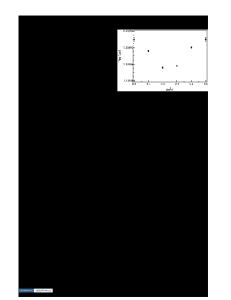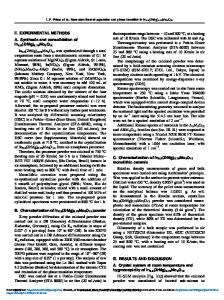Tailoring the thermal expansion anisotropy of Mo 5 Si 3
- PDF / 1,210,027 Bytes
- 6 Pages / 612 x 792 pts (letter) Page_size
- 83 Downloads / 344 Views
Tailoring the thermal expansion anisotropy of Mo5Si3 Joachim H. Schneibel, Claudia J. Rawn, Chong Long Fu Metals and Ceramics Division, Oak Ridge National Laboratory, Oak Ridge, TN 37831, U.S.A. ABSTRACT The silicide Mo5Si3, with the W5Si3 structure, exhibits a high anisotropy of its coefficients of thermal expansion (CTEs) in the a and c directions, namely, CTE(c)/CTE(a)=2.2. In order to determine whether the CTE anisotropy can be controlled, molybdenum was partially substituted with Nb. CTEs were determined by high temperature x-ray powder diffraction. Partial substitution with 44 at. % Nb reduced the value of CTE(c)/CTE(a) to a value near 1. For higher Nb concentrations, CTE(c)/CTE(a) increased again. When nearly all the Mo was replaced by Nb, the crystal structure changed to the Cr5B3 structure type and the CTE anisotropy decreased to a value near 1. Our thermal expansion results are interpreted in terms of the site occupation of Nb, the Nb-induced increase in the interatomic spacing of the Mo atom chains along the cdirection, and the reduction in the anisotropy of the lattice anharmonicity in the a and c directions. INTRODUCTION In the search for high-temperature structural materials, molybdenum silicides have frequently been considered as potential solutions [1]. Recently, Akinc and collaborators [2,3] have studied boron-containing molybdenum silicide alloys consisting of the phases Mo3Si, Mo5Si3, and Mo5SiB2. These authors suggest that the Mo5Si3 phase is responsible for the high creep strength of these alloys. In order to further understand the Mo5Si3 phase Chu et al. [4] investigated Mo5Si3 single crystals. They found that the thermal expansion coefficients (CTEs) in the c and a directions of the tetragonal crystal structure of Mo5Si3 differed by more than a factor of 2. Unless the grain is sufficiently small (as it was in Akinc et al’s experiments), such high CTE ratios result in micro-cracking and degrade the mechanical properties [5]. Fu et al. [6,7] performed ab-initio calculations of the CTEs of Mo5Si3. They obtained good agreement with Chu et al.’s experimental data and attributed the high CTE ratio of Mo5Si3 to the elastic rigidity of its basal planes and a high anharmonicity along the c-axis. The high anharmonicity along the c-axis was attributed to the presence of Mo-chains along the c-axis with unusually short atomic distances. Recently, Ikarashi et al. [8] found that the CTE anisotropy of the tetragonal silicide Ti5Si3 could be significantly reduced by partial substitution of Ti atoms with larger Zr atoms. Whereas the CTE ratio, CTE(c)/CTE(a), for Ti5Si3 was 1.68, the corresponding value for Ti2Zr3Si3 was only 1.22. The purpose of the present work is to determine whether ternary alloying additions to Mo5Si3 can reduce the CTE anisotropy. It turns out that partial substitution of Mo atoms with (distinctly larger) Nb atoms is very effective in reducing the CTE anisotropy of Mo5Si3 type compounds.
N5.40.1
EXPERIMENTAL DETAILS Buttons of (Mo1-xNbx)5Si3 alloys with several Nb concentrations were pr
Data Loading...











